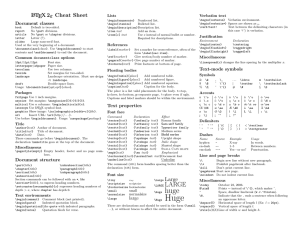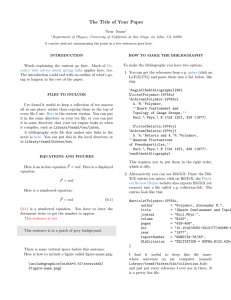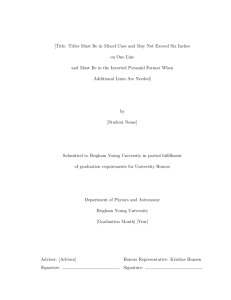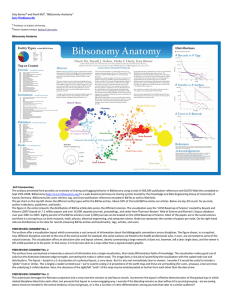B TEXing 1 Overview
advertisement
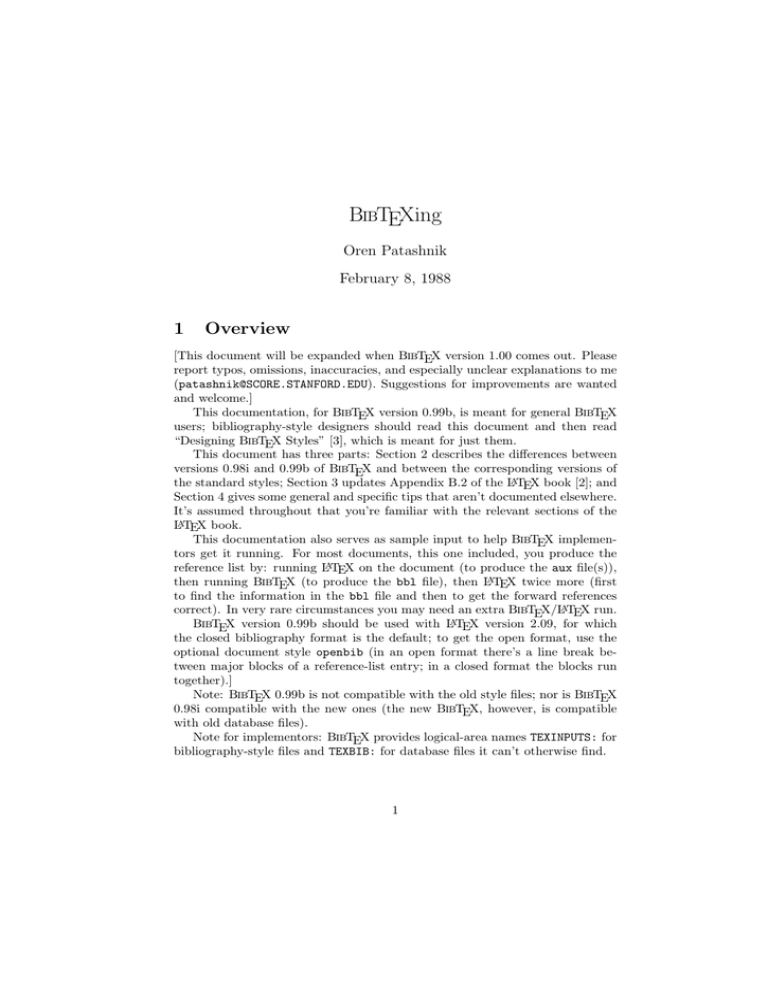
BIBTEXing
Oren Patashnik
February 8, 1988
1
Overview
[This document will be expanded when BibTEX version 1.00 comes out. Please
report typos, omissions, inaccuracies, and especially unclear explanations to me
(patashnik@SCORE.STANFORD.EDU). Suggestions for improvements are wanted
and welcome.]
This documentation, for BibTEX version 0.99b, is meant for general BibTEX
users; bibliography-style designers should read this document and then read
“Designing BibTEX Styles” [3], which is meant for just them.
This document has three parts: Section 2 describes the differences between
versions 0.98i and 0.99b of BibTEX and between the corresponding versions of
the standard styles; Section 3 updates Appendix B.2 of the LATEX book [2]; and
Section 4 gives some general and specific tips that aren’t documented elsewhere.
It’s assumed throughout that you’re familiar with the relevant sections of the
LATEX book.
This documentation also serves as sample input to help BibTEX implementors get it running. For most documents, this one included, you produce the
reference list by: running LATEX on the document (to produce the aux file(s)),
then running BibTEX (to produce the bbl file), then LATEX twice more (first
to find the information in the bbl file and then to get the forward references
correct). In very rare circumstances you may need an extra BibTEX/LATEX run.
BibTEX version 0.99b should be used with LATEX version 2.09, for which
the closed bibliography format is the default; to get the open format, use the
optional document style openbib (in an open format there’s a line break between major blocks of a reference-list entry; in a closed format the blocks run
together).]
Note: BibTEX 0.99b is not compatible with the old style files; nor is BibTEX
0.98i compatible with the new ones (the new BibTEX, however, is compatible
with old database files).
Note for implementors: BibTEX provides logical-area names TEXINPUTS: for
bibliography-style files and TEXBIB: for database files it can’t otherwise find.
1
2
Changes
This section describes the differences between BibTEX versions 0.98i and 0.99b,
and also between the corresponding standard styles. There were a lot of differences; there will be a lot fewer between 0.99 and 1.00.
2.1
New BibTEX features
The following list explains BibTEX’s new features and how to use them.
1. With the single command ‘\nocite{*}’ you can now include in the reference list every entry in the database files, without having to explicitly
\cite or \nocite each entry. Giving this command, in essence, \nocites
all the enties in the database, in database order, at the very spot in your
document where you give the command.
2. You can now have as a field value (or an @STRING definition) the concatenation of several strings. For example if you’ve defined
@STRING( WGA = " World Gnus Almanac" )
then it’s easy to produce nearly-identical title fields for different entries:
@BOOK(almanac-66,
title = 1966 # WGA,
. . .
@BOOK(almanac-67,
title = 1967 # WGA,
and so on. Or, you could have a field like
month = "1~" # jan,
which would come out something like ‘1~January’ or ‘1~Jan.’ in the bbl
file, depending on how your bibliography style defines the jan abbreviation. You may concatenate as many strings as you like (except that there’s
a limit to the overall length of the resulting field); just be sure to put the
concatenation character ‘#’, surrounded by optional spaces or newlines,
between each successive pair of strings.
3. BibTEX has a new cross-referencing feature, explained by an example.
Suppose you say \cite{no-gnats} in your document, and suppose you
have these two entries in your database file:
2
@INPROCEEDINGS(no-gnats,
crossref = "gg-proceedings",
author = "Rocky Gneisser",
title = "No Gnats Are Taken for Granite",
pages = "133-139")
. . .
@PROCEEDINGS(gg-proceedings,
editor = "Gerald Ford and Jimmy Carter",
title = "The Gnats and Gnus 1988 Proceedings",
booktitle = "The Gnats and Gnus 1988 Proceedings")
Two things happen. First, the special crossref field tells BibTEX that
the no-gnats entry should inherit any fields it’s missing from the entry
it cross references, gg-proceedings. In this case it in inherits the two
fields editor and booktitle. Note that, in the standard styles at least,
the booktitle field is irrelevant for the PROCEEDINGS entry type. The
booktitle field appears here in the gg-proceedings entry only so that
the entries that cross reference it may inherit the field. No matter how
many papers from this meeting exist in the database, this booktitle field
need only appear once.
The second thing that happens: BibTEX automatically puts the entry
gg-proceedings into the reference list if it’s cross referenced by two
or more entries that you \cite or \nocite, even if you don’t \cite or
\nocite the gg-proceedings entry itself. So gg-proceedings will automatically appear on the reference list if one other entry besides no-gnats
cross references it.
To guarantee that this scheme works, however, a cross-referenced entry
must occur later in the database files than every entry that cross-references
it. Thus, putting all cross-referenced entries at the end makes sense.
(Moreover, you may not reliably nest cross references; that is, a crossreferenced entry may not itself reliably cross reference an entry. This is
almost certainly not something you’d want to do, though.)
One final note: This cross-referencing feature is completely unrelated to
the old BibTEX’s cross referencing, which is still allowed. Thus, having a
field like
note = "Jones \cite{jones-proof} improves the result"
is not affected by the new feature.
4. BibTEX now handles accented characters. For example if you have an
entry with the two fields
3
author = "Kurt G{\"o}del",
year = 1931,
and if you’re using the alpha bibliography style, then BibTEX will construct the label [Göd31] for this entry, which is what you’d want. To get
this feature to work you must place the entire accented character in braces;
in this case either {\"o} or {\"{o}} will do. Furthermore these braces
must not themselves be enclosed in braces (other than the ones that might
delimit the entire field or the entire entry); and there must be a backslash
as the very first character inside the braces. Thus neither {G{\"{o}}del}
nor {G\"{o}del} will work for this example.
This feature handles all the accented characters and all but the nonbackslashed foreign symbols found in Tables 3.1 and 3.2 of the LATEX book.
This feature behaves similarly for “accents” you might define; we’ll see an
example shortly. For the purposes of counting letters in labels, BibTEX
considers everything contained inside the braces as a single letter.
5. BibTEX also handles hyphenated names. For example if you have an entry
with
author = "Jean-Paul Sartre",
and if you’re using the abbrv style, then the result is ‘J.-P. Sartre’.
6. There’s now an @PREAMBLE command for the database files. This command’s syntax is just like @STRING’s, except that there is no name or
equals-sign, just the string. Here’s an example:
@PREAMBLE{ "\newcommand{\noopsort}[1]{} "
# "\newcommand{\singleletter}[1]{#1} " }
(note the use of concatenation here, too). The standard styles output
whatever information you give this command (LATEX macros most likely)
directly to the bbl file. We’ll look at one possible use of this command,
based on the \noopsort command just defined.
The issue here is sorting (alphabetizing). BibTEX does a pretty good job,
but occasionally weird circumstances conspire to confuse BibTEX: Suppose
that you have entries in your database for the two books in a two-volume
set by the same author, and that you’d like volume 1 to appear just before
volume 2 in your reference list. Further suppose that there’s now a second
edition of volume 1, which came out in 1973, say, but that there’s still
just one edition of volume 2, which came out in 1971. Since the plain
standard style sorts by author and then year, it will place volume 2 first
(because its edition came out two years earlier) unless you help BibTEX.
You can do this by using the year fields below for the two volumes:
4
year = "{\noopsort{a}}1973"
. . .
year = "{\noopsort{b}}1971"
According to the definition of \noopsort, LATEX will print nothing but
the true year for these fields. But BibTEX will be perfectly happy pretending that \noopsort specifies some fancy accent that’s supposed to
adorn the ‘a’ and the ‘b’; thus when BibTEX sorts it will pretend that
‘a1973’ and ‘b1971’ are the real years, and since ‘a’ comes before ‘b’, it
will place volume 1 before volume 2, just what you wanted. By the way,
if this author has any other works included in your database, you’d probably want to use instead something like {\noopsort{1968a}}1973 and
{\noopsort{1968b}}1971, so that these two books would come out in a
reasonable spot relative to the author’s other works (this assumes that
1968 results in a reasonable spot, say because that’s when the first edition
of volume 1 appeared).
There is a limit to the number of @PREAMBLE commands you may use, but
you’ll never exceed this limit if you restrict yourself to one per database file;
this is not a serious restriction, given the concatenation feature (item 2).
7. BibTEX’s sorting algorithm is now stable. This means that if two entries
have identical sort keys, those two entries will appear in citation order.
(The bibliography styles construct these sort keys—usually the author
information followed by the year and the title.)
8. BibTEX no longer does case conversion for file names; this will make
BibTEX easier to install on Unix systems, for example.
9. It’s now easier to add code for processing a command-line aux-file name.
2.2
Changes to the standard styles
This section describes changes to the standard styles (plain, unsrt, alpha,
abbrv) that affect ordinary users. Changes that affect style designers appear in
the document “Designing BibTEX Styles” [3].
1. In general, sorting is now by “author”, then year, then title—the old versions didn’t use the year field. (The alpha style, however, sorts first by
label, then “author”, year, and title.) The quotes around author mean
that some entry types might use something besides the author, like the
editor or organization.
2. Many unnecessary ties (~) have been removed. LATEX thus will produce
slightly fewer ‘Underfull \hbox’ messages when it’s formatting the reference list.
5
3. Emphasizing ({\em ...}) has replaced italicizing ({\it ...}). This will
almost never result in a difference between the old output and the new.
4. The alpha style now uses a superscripted ‘+ ’ instead of a ‘*’ to represent names omitted in constructing the label. If you really liked it
the way it was, however, or if you want to omit the character entirely,
you don’t have to modify the style file—you can override the ‘+ ’ by redefining the \etalchar command that the alpha style writes onto the
bbl file (just preceding the \thebibliography environment); use LATEX’s
\renewcommand inside a database @PREAMBLE command, described in the
previous subsection’s item 6.
5. The abbrv style now uses ‘Mar.’ and ‘Sept.’ for those months rather than
‘March’ and ‘Sep.’
6. The standard styles use BibTEX’s new cross-referencing feature by giving
a \cite of the cross-referenced entry and by omitting from the crossreferencing entry (most of the) information that appears in the crossreferenced entry. These styles do this when a titled thing (the crossreferencing entry) is part of a larger titled thing (the cross-referenced
entry). There are five such situations: when (1) an INPROCEEDINGS (or
CONFERENCE, which is the same) cross references a PROCEEDINGS; when
(2) a BOOK, (3) an INBOOK, or (4) an INCOLLECTION cross references a
BOOK (in these cases, the cross-referencing entry is a single volume in a
multi-volume work); and when (5) an ARTICLE cross references an ARTICLE
(in this case, the cross-referenced entry is really a journal, but there’s no
JOURNAL entry type; this will result in warning messages about an empty
author and title for the journal—you should just ignore these warnings).
7. The MASTERSTHESIS and PHDTHESIS entry types now take an optional type
field. For example you can get the standard styles to call your reference a
‘Ph.D. dissertation’ instead of the default ‘PhD thesis’ by including a
type = "{Ph.D.} dissertation"
in your database entry.
8. Similarly, the INBOOK and INCOLLECTION entry types now take an optional
type field, allowing ‘section 1.2’ instead of the default ‘chapter 1.2’. You
get this by putting
chapter = "1.2",
type = "Section"
in your database entry.
6
9. The BOOKLET, MASTERSTHESIS, and TECHREPORT entry types now format
their title fields as if they were ARTICLE titles rather than BOOK titles.
10. The PROCEEDINGS and INPROCEEDINGS entry types now use the address
field to tell where a conference was held, rather than to give the address
of the publisher or organization. If you want to include the publisher’s or
organization’s address, put it in the publisher or organization field.
11. The BOOK, INBOOK, INCOLLECTION, and PROCEEDINGS entry types now allow either volume or number (but not both), rather than just volume.
12. The INCOLLECTION entry type now allows a series and an edition field.
13. The INPROCEEDINGS and PROCEEDINGS entry types now allow either a
volume or number, and also a series field.
14. The UNPUBLISHED entry type now outputs, in one block, the note field
followed by the date information.
15. The MANUAL entry type now prints out the organization in the first block
if the author field is empty.
16. The MISC entry type now issues a warning if all the optional fields are
empty (that is, if the entire entry is empty).
3
The Entries
This section is simply a corrected version of Appendix B.2 of the LATEX book [2],
c 1986, by Addison-Wesley. The basic scheme is the same, only a few details
have changed.
3.1
Entry Types
When entering a reference in the database, the first thing to decide is what
type of entry it is. No fixed classification scheme can be complete, but BibTEX
provides enough entry types to handle almost any reference reasonably well.
References to different types of publications contain different information;
a reference to a journal article might include the volume and number of the
journal, which is usually not meaningful for a book. Therefore, database entries
of different types have different fields. For each entry type, the fields are divided
into three classes:
required Omitting the field will produce a warning message and, rarely, a
badly formatted bibliography entry. If the required information is not
meaningful, you are using the wrong entry type. However, if the required
information is meaningful but, say, already included is some other field,
simply ignore the warning.
7
optional The field’s information will be used if present, but can be omitted
without causing any formatting problems. You should include the optional
field if it will help the reader.
ignored The field is ignored. BibTEX ignores any field that is not required or
optional, so you can include any fields you want in a bib file entry. It’s a
good idea to put all relevant information about a reference in its bib file
entry—even information that may never appear in the bibliography. For
example, if you want to keep an abstract of a paper in a computer file, put
it in an abstract field in the paper’s bib file entry. The bib file is likely
to be as good a place as any for the abstract, and it is possible to design a
bibliography style for printing selected abstracts. Note: Misspelling a field
name will result in its being ignored, so watch out for typos (especially
for optional fields, since BibTEX won’t warn you when those are missing).
The following are the standard entry types, along with their required and
optional fields, that are used by the standard bibliography styles. The fields
within each class (required or optional) are listed in order of occurrence in the
output, except that a few entry types may perturb the order slightly, depending
on what fields are missing. These entry types are similar to those adapted
by Brian Reid from the classification scheme of van Leunen [4] for use in the
Scribe system. The meanings of the individual fields are explained in the next
section. Some nonstandard bibliography styles may ignore some optional fields
in creating the reference. Remember that, when used in the bib file, the entrytype name is preceded by an @ character.
article An article from a journal or magazine. Required fields: author, title,
journal, year. Optional fields: volume, number, pages, month, note.
book A book with an explicit publisher. Required fields: author or editor,
title, publisher, year. Optional fields: volume or number, series,
address, edition, month, note.
booklet A work that is printed and bound, but without a named publisher or
sponsoring institution. Required field: title. Optional fields: author,
howpublished, address, month, year, note.
conference The same as INPROCEEDINGS, included for Scribe compatibility.
inbook A part of a book, which may be a chapter (or section or whatever)
and/or a range of pages. Required fields: author or editor, title,
chapter and/or pages, publisher, year. Optional fields: volume or
number, series, type, address, edition, month, note.
incollection A part of a book having its own title. Required fields: author,
title, booktitle, publisher, year. Optional fields: editor, volume or
number, series, type, chapter, pages, address, edition, month, note.
8
inproceedings An article in a conference proceedings. Required fields:
author, title, booktitle, year. Optional fields: editor, volume or
number, series, pages, address, month, organization, publisher,
note.
manual Technical documentation. Required field: title. Optional fields:
author, organization, address, edition, month, year, note.
mastersthesis A Master’s thesis. Required fields: author, title, school,
year. Optional fields: type, address, month, note.
misc Use this type when nothing else fits. Required fields: none. Optional
fields: author, title, howpublished, month, year, note.
phdthesis A PhD thesis. Required fields: author, title, school, year. Optional fields: type, address, month, note.
proceedings The proceedings of a conference. Required fields: title, year.
Optional fields: editor, volume or number, series, address, month,
organization, publisher, note.
techreport A report published by a school or other institution, usually numbered within a series. Required fields: author, title, institution, year.
Optional fields: type, number, address, month, note.
unpublished A document having an author and title, but not formally published. Required fields: author, title, note. Optional fields: month,
year.
In addition to the fields listed above, each entry type also has an optional key
field, used in some styles for alphabetizing, for cross referencing, or for forming
a \bibitem label. You should include a key field for any entry whose “author”
information is missing; the “author” information is usually the author field,
but for some entry types it can be the editor or even the organization field
(Section 4 describes this in more detail). Do not confuse the key field with the
key that appears in the \cite command and at the beginning of the database
entry; this field is named “key” only for compatibility with Scribe.
3.2
Fields
Below is a description of all fields recognized by the standard bibliography styles.
An entry can also contain other fields, which are ignored by those styles.
address Usually the address of the publisher or other type of institution. For
major publishing houses, van Leunen recommends omitting the information entirely. For small publishers, on the other hand, you can help the
reader by giving the complete address.
9
annote An annotation. It is not used by the standard bibliography styles, but
may be used by others that produce an annotated bibliography.
author The name(s) of the author(s), in the format described in the LATEX
book.
booktitle Title of a book, part of which is being cited. See the LATEX book for
how to type titles. For book entries, use the title field instead.
chapter A chapter (or section or whatever) number.
crossref The database key of the entry being cross referenced.
edition The edition of a book—for example, “Second”. This should be an
ordinal, and should have the first letter capitalized, as shown here; the
standard styles convert to lower case when necessary.
editor Name(s) of editor(s), typed as indicated in the LATEX book. If there is
also an author field, then the editor field gives the editor of the book or
collection in which the reference appears.
howpublished How something strange has been published. The first word
should be capitalized.
institution The sponsoring institution of a technical report.
journal A journal name. Abbreviations are provided for many journals; see
the Local Guide.
key Used for alphabetizing, cross referencing, and creating a label when the
“author” information (described in Section 4) is missing. This field should
not be confused with the key that appears in the \cite command and at
the beginning of the database entry.
month The month in which the work was published or, for an unpublished
work, in which it was written. You should use the standard three-letter
abbreviation, as described in Appendix B.1.3 of the LATEX book.
note Any additional information that can help the reader. The first word
should be capitalized.
number The number of a journal, magazine, technical report, or of a work in a
series. An issue of a journal or magazine is usually identified by its volume
and number; the organization that issues a technical report usually gives
it a number; and sometimes books are given numbers in a named series.
organization The organization that sponsors a conference or that publishes a
manual.
10
pages One or more page numbers or range of numbers, such as 42--111 or
7,41,73--97 or 43+ (the ‘+’ in this last example indicates pages following
that don’t form a simple range). To make it easier to maintain Scribecompatible databases, the standard styles convert a single dash (as in
7-33) to the double dash used in TEX to denote number ranges (as in
7--33).
publisher The publisher’s name.
school The name of the school where a thesis was written.
series The name of a series or set of books. When citing an entire book, the
the title field gives its title and an optional series field gives the name
of a series or multi-volume set in which the book is published.
title The work’s title, typed as explained in the LATEX book.
type The type of a technical report—for example, “Research Note”.
volume The volume of a journal or multivolume book.
year The year of publication or, for an unpublished work, the year it was written. Generally it should consist of four numerals, such as 1984, although
the standard styles can handle any year whose last four nonpunctuation
characters are numerals, such as ‘(about 1984)’.
4
Helpful Hints
This section gives some random tips that aren’t documented elsewhere, at least
not in this detail. They are, roughly, in order of least esoteric to most. First,
however, a brief spiel.
I understand that there’s often little choice in choosing a bibliography style—
journal X says you must use style Y and that’s that. If you have a choice,
however, I strongly recommend that you choose something like the plain standard style. Such a style, van Leunen [4] argues convincingly, encourages better
writing than the alternatives—more concrete, more vivid.
The Chicago Manual of Style [1], on the other hand, espouse the authordate system, in which the citation might appear in the text as ‘(Jones, 1986)’.
I argue that this system, besides cluttering up the text with information that
may or may not be relevant, encourages the passive voice and vague writing.
Furthermore the strongest arguments for using the author-date system—like
“it’s the most practical”—fall flat on their face with the advent of computertypesetting technology. For instance the Chicago Manual contains, right in
the middle of page 401, this anachronism: “The chief disadvantage of [a style
like plain] is that additions or deletions cannot be made after the manuscript
11
is typed without changing numbers in both text references and list.” LATEX,
obviously, sidesteps the disadvantage.
Finally, the logical deficiencies of the author-date style are quite evident once
you’ve written a program to implement it. For example, in a large bibliography,
using the standard alphabetizing scheme, the entry for ‘(Aho et al., 1983b)’
might be half a page later than the one for ‘(Aho et al., 1983a)’. Fixing this
problem results in even worse ones. What a mess. (I have, unfortunately,
programmed such a style, and if you’re saddled with an unenlightened publisher
or if you don’t buy my propaganda, it’s available from the Rochester style
collection.)
Ok, so the spiel wasn’t very brief; but it made me feel better, and now my
blood pressure is back to normal. Here are the tips for using BibTEX with the
standard styles (although many of them hold for nonstandard styles, too).
1. With BibTEX’s style-designing language you can program general database
manipulations, in addition to bibliography styles. For example it’s a fairly
easy task for someone familiar with the language to produce a databasekey/author index of all the entries in a database. Consult the Local Guide
to see what tools are available on your system.
2. The standard style’s thirteen entry types do reasonably well at formatting
most entries, but no scheme with just thirteen formats can do everything
perfectly. Thus, you should feel free to be creative in how you use these
entry types (but if you have to be too creative, there’s a good chance
you’re using the wrong entry type).
3. Don’t take the field names too seriously. Sometimes, for instance, you
might have to include the publisher’s address along with the publisher’s
name in the publisher field, rather than putting it in the address field.
Or sometimes, difficult entries work best when you make judicious use of
the note field.
4. Don’t take the warning messages too seriously. Sometimes, for instance,
the year appears in the title, as in The 1966 World Gnus Almanac. In
this case it’s best to omit the year field and to ignore BibTEX’s warning
message.
5. If you have too many names to list in an author or editor field, you can
end the list with “and others”; the standard styles appropriately append
an “et al.”
6. In general, if you want to keep BibTEX from changing something to lower
case, you enclose it in braces. You might not get the effect you want,
however, if the very first character after the left brace is a backslash. The
“special characters” item later in this section explains.
12
7. For Scribe compatibility, the database files allow an @COMMENT command;
it’s not really needed because BibTEX allows in the database files any
comment that’s not within an entry. If you want to comment out an
entry, simply remove the ‘@’ character preceding the entry type.
8. The standard styles have journal abbreviations that are computer-science
oriented; these are in the style files primarily for the example. If you
have a different set of journal abbreviations, it’s sensible to put them in
@STRING commands in their own database file and to list this database file
as an argument to LATEX’s \bibliography command (but you should list
this argument before the ones that specify real database entries).
9. It’s best to use the three-letter abbreviations for the month, rather than
spelling out the month yourself. This lets the bibliography style be consistent. And if you want to include information for the day of the month,
the month field is usually the best place. For example
month = jul # "~4,"
will probably produce just what you want.
10. If you’re using the unsrt style (references are listed in order of citation)
along with the \nocite{*} feature (all entries in the database are included), the placement of the \nocite{*} command within your document file will determine the reference order. According to the rule given
in Section 2.1: If the command is placed at the beginning of the document,
the entries will be listed in exactly the order they occur in the database;
if it’s placed at the end, the entries that you explicitly \cite or \nocite
will occur in citation order, and the remaining database entries will be in
database order.
11. For theses, van Leunen recommends not giving the school’s department
after the name of the degree, since schools, not departments, issue degrees.
If you really think that giving the department information will help the
reader find the thesis, put that information in the address field.
12. The MASTERSTHESIS and PHDTHESIS entry types are so named for Scribe
compatibility; MINORTHESIS and MAJORTHESIS probably would have been
better names. Keep this in mind when trying to classify a non-U.S. thesis.
13. Here’s yet another suggestion for what to do when an author’s name appears slightly differently in two publications. Suppose, for example, two
journals articles use these fields.
author = "Donald E. Knuth"
. . .
author = "D. E. Knuth"
13
There are two possibilities. You could (1) simply leave them as is, or (2) assuming you know for sure that these authors are one and the same person,
you could list both in the form that the author prefers (say, ‘Donald E.
Knuth’). In the first case, the entries might be alphabetized incorrectly,
and in the second, the slightly altered name might foul up somebody’s
electronic library search. But there’s a third possibility, which is the one
I prefer. You could convert the second journal’s field to
author = "D[onald] E. Knuth"
This avoids the pitfalls of the previous two solutions, since BibTEX alphabetizes this as if the brackets weren’t there, and since the brackets clue the
reader in that a full first name was missing from the original. Of course
it introduces another pitfall—‘D[onald] E. Knuth’ looks ugly—but in this
case I think the increase in accuracy outweighs the loss in aesthetics.
14. LATEX’s comment character ‘%’ is not a comment character in the database
files.
15. Here’s a more complete description of the “author” information referred
to in previous sections. For most entry types the “author” information is
simply the author field. However: For the BOOK and INBOOK entry types
it’s the author field, but if there’s no author then it’s the editor field;
for the MANUAL entry type it’s the author field, but if there’s no author
then it’s the organization field; and for the PROCEEDINGS entry type it’s
the editor field, but if there’s no editor then it’s the organization field.
16. When creating a label, the alpha style uses the “author” information described above, but with a slight change—for the MANUAL and PROCEEDINGS
entry types, the key field takes precedence over the organization field.
Here’s a situation where this is useful.
organization = "The Association for Computing Machinery",
key = "ACM"
Without the key field, the alpha style would make a label from the first
three letters of information in the organization field; alpha knows to
strip off the ‘The ’, but it would still form a label like ‘[Ass86]’, which,
however intriguing, is uninformative. Including the key field, as above,
would yield the better label ‘[ACM86]’.
You won’t always need the key field to override the organization, though:
With
organization = "Unilogic, Ltd.",
14
for instance, the alpha style would form the perfectly reasonable label
‘[Uni86]’.
17. Section 2.1 discusses accented characters. To BibTEX, an accented character is really a special case of a “special character”, which consists of
everything from a left brace at the top-most level, immediately followed
by a backslash, up through the matching right brace. For example in the
field
author = "\AA{ke} {Jos{\’{e}} {\’{E}douard} G{\"o}del"
there are just two special characters, ‘{\’{E}douard}’ and ‘{\"o}’ (the
same would be true if the pair of double quotes delimiting the field were
braces instead). In general, BibTEX will not do any processing of a TEX
or LATEX control sequence inside a special character, but it will process
other characters. Thus a style that converts all titles to lower case would
convert
The {\TeX BOOK\NOOP} Experience
to
The {\TeX book\NOOP} experience
(the ‘The’ is still capitalized because it’s the first word of the title).
This special-character scheme is useful for handling accented characters,
for getting BibTEX’s alphabetizing to do what you want, and, since BibTEX
counts an entire special character as just one letter, for stuffing extra
characters inside labels. The file XAMPL.BIB distributed with BibTEX gives
examples of all three uses.
18. This final item of the section describes BibTEX’s names (which appear in
the author or editor field) in slightly more detail than what appears in
Appendix B of the LATEX book. In what follows, a “name” corresponds to
a person. (Recall that you separate multiple names in a single field with
the word “and”, surrounded by spaces, and not enclosed in braces. This
item concerns itself with the structure of a single name.)
Each name consists of four parts: First, von, Last, and Jr; each part
consists of a (possibly empty) list of name-tokens. The Last part will be
nonempty if any part is, so if there’s just one token, it’s always a Last
token.
Recall that Per Brinch Hansen’s name should be typed
"Brinch Hansen, Per"
15
The First part of his name has the single token “Per”; the Last part has
two tokens, “Brinch” and “Hansen”; and the von and Jr parts are empty.
If you had typed
"Per Brinch Hansen"
instead, BibTEX would (erroneously) think “Brinch” were a First-part
token, just as “Paul” is a First-part token in “John Paul Jones”, so this
erroneous form would have two First tokens and one Last token.
Here’s another example:
"Charles Louis Xavier Joseph de la Vall{\’e}e Poussin"
This name has four tokens in the First part, two in the von, and two in
the Last. Here BibTEX knows where one part ends and the other begins
because the tokens in the von part begin with lower-case letters.
In general, it’s a von token if the first letter at brace-level 0 is in lower
case. Since technically everything in a “special character” is at bracelevel 0, you can trick BibTEX into thinking that a token is or is not a von
token by prepending a dummy special character whose first letter past the
TEX control sequence is in the desired case, upper or lower.
To summarize, BibTEX allows three possible forms for the name:
"First von Last"
"von Last, First"
"von Last, Jr, First"
You may almost always use the first form; you shouldn’t if either there’s
a Jr part, or the Last part has multiple tokens but there’s no von part.
References
[1] The Chicago Manual of Style, pages 400–401. University of Chicago Press,
thirteenth edition, 1982.
[2] Leslie Lamport. LATEX: A Document Preparation System. Addison-Wesley,
1986.
[3] Oren Patashnik. Designing BibTEX styles. The part of BibTEX’s documentation that’s not meant for general users, 8 February 1988.
[4] Mary-Claire van Leunen. A Handbook for Scholars. Knopf, 1979.
16

